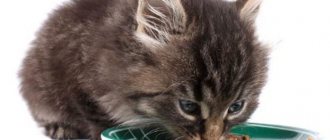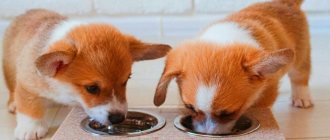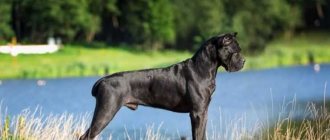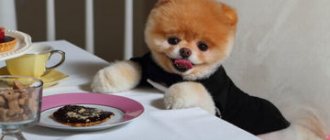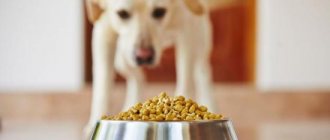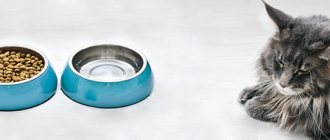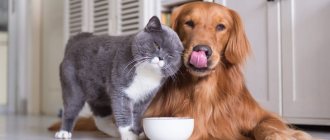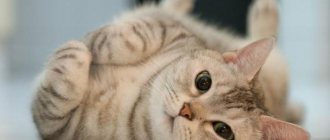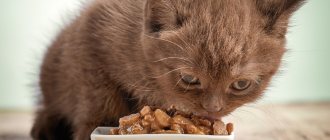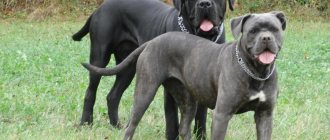The Cane Corso is an Italian breed whose roots originate from the fighting dogs of Ancient Rome. In past centuries, it was used for hunting, protecting property, participating in dog fights, and even herding livestock. In the second half of the 20th century, the breed was on the verge of extinction. But, fortunately, the scientist Giovanni Bonatti, convinced of its value, managed to find and revive it.
Today, Cane Corsos are, first of all, reliable companions and guards. Among them are police and search dogs. Despite their rather formidable appearance and military background, they get along well with children and are ready to play with them all day long. These dogs are only aggressive towards strangers, especially when they try to offend their owners or enter a protected area. The relationship between the “Italian” and other pets in the house depends on his upbringing: if the puppy has been taught to interact with them from an early age, he will be calm and patient.
Regular exercise and proper nutrition are important for the Cane Corso. Without this, the dog will not be able to gain sufficient muscle mass and will look weak and loose. The basic principles of diet composition are the same as for other large breeds: it should be similar to what canines feed in their natural habitat.
What to feed the Cane Corso: dry or natural
A similar question faces all new owners of a small pet of any breed. But in the case of Cane Corso, most often breeders and owners give preference to dry food, since Cane Corso are prone to food allergies. In this case, the question arises about the constant purchase of expensive hypoallergenic diets, and this is quite an expensive matter.
The advantage of dry diets is their ease of use and accurate dosing - just study the information on the packaging. And if the pet starts to be “capricious,” then you can diversify the menu with canned food, but preferably of the same brand as the main food.
If such a problem as allergic manifestations is avoided, then you can give preference to natural nutrition, but it must be balanced, include only approved products and be regularly adjusted, depending on the time of year, the growth of the pet and its condition.
And it’s worth remembering - if a dog eats dried food, then it’s better for him to buy “treats” from a pet store, but with natural feeding, you can choose a treat from your pet’s favorite foods or dry the meat and use it.
Feeding
Compound
The Cane Corso's diet does not contain potential allergens (chicken, toxic dyes, aromatic additives).
The following products are used to create complete mixtures:
- Lamb fillet, rabbit, veal, poultry;
- Fish;
- Cereals - barley, wheat, rice, corn;
- Beans and soybeans;
- Vegetable fiber;
- Animal fats;
- Complexes of plant extracts;
- Antioxidants, minerals and vitamins.
Economy and premium food categories contain preservatives, and the protein for them is obtained by processing offal. In the super premium and holistic series, only organic meat and fish are used, and preservatives are replaced with antioxidants.
Choice
For your pet, you need to select a mixture according to the following criteria:
- Age;
- Presence of diseases (dietary diet taking into account the diagnosis);
- Physiological characteristics (pregnancy, molting, feeding);
- Average level of activity.
Incorrectly selected food leads to weight loss, muscle mass and health problems.
What to feed a Cane Corso puppy
Compared to representatives of other breeds, the Cane Corso's maturation lasts quite a long time and throughout this period the pet must be fed according to a special, “puppy” diet. This also applies to the frequency of feedings - it will last longer than with other dogs.
You can switch the puppy to a new diet only 2 weeks after he has settled in his new home. And at first it is advisable to adhere to the schedule that was used when the baby lived with his family. You should decide on a feeding schedule, making equal time intervals between meals.
Such a large, muscular dog needs an increased amount of proteins of animal origin. And the sources of this component are meat, fish, offal, eggs. Babies under 2.5 months old are given meat cut into small pieces, but twisted minced meat is practically not absorbed by the puppy’s body.
Beef, veal, and rabbit meat are suitable for feeding your baby. A couple of times every 7 days, you can treat your pet to fish - low-fat, sea fish, boiled and deboned. Large beef bones can be given to a puppy at 5-6 months, when teeth begin to change.
From six months you can include tripe (the gastric tissue of herbivorous cattle) in your diet, although nutritionally it is much poorer than meat, but it contains a large amount of enzyme substances that have a beneficial effect on the functioning of the digestive tract. When giving this product, it is worth remembering that it should make up no more than half of the daily meat portion.
Belcando Junior Maxi for large and giant breed puppies from 3 to 18 months (15 kg)
Many experts recommend Belcando Junior, made in Germany, for large dogs. Its composition is rich in a high content of poultry meat, in addition to easily digestible rice, which helps good digestion and absorption of useful components. The recipe contains carob fruits, which contain tannins and substances important for life that have an effect on proper digestion. Belongs to the super premium class.
pros
- A complete, balanced complex of nutrients.
- Healthy pet.
- Convenient, economical packaging.
- A wide range of.
- Availability.
- German quality.
Minuses
- Causes an allergic reaction.
- Not all dogs like it.
- Not sold in all Russian cities.
- Composition with sodium chloride.
- Large granules of strange color.
- Poor combination with vitamins and other products.
- There is a minimum of meat, but a maximum of cereals.
What to feed an adult Cane Corso
And in adulthood, the Cane Corso needs protein, so the diet is based on meat, and the pet is also given offal and fermented milk products. The ideal fish for the diet of dogs of this breed is blue whiting; it is given in its entirety, and it is also a good idea to supplement your pet’s menu with salmon breeds. Fish is given every 3-4 days, 1 kilogram at a time.
The menu should also include porridges cooked in vegetable or meat broths. Pieces of meat and vegetables are added to them, and they can be seasoned with either vegetable or butter. The dog should also eat vegetables regularly: cabbage, carrots, zucchini, and pumpkin are allowed. You can add fresh herbs to your dishes.
You can give your dog fruit as a treat: pieces of apples, pears, apricots, peaches. Fresh berries will help diversify the menu: raspberries, lingonberries, blueberries. You can make salads - season vegetable salads with a small amount of vegetable oil, fruit salads - with low-fat yogurt without additives.
When feeding dry diets, it is important to follow the instructions; the food must be high quality and suitable for large breeds. And be sure to provide your dog with plenty of water.
How to choose?
You need to choose only high-quality dry food that is suitable for the age and health of the dog.
An adult and active Cane Corso requires about 800 pellets per day.
IMPORTANT!
You can calculate the amount of feed as follows: per kilogram of animal body weight, about 30 grams of feed are required.
Veterinarians advise paying attention to super premium and holistic food.
What not to feed your Cane Corso
The following foods may be harmful to your health:
- boiled bones, tubular (bones can get stuck in the throat);
- pork;
- salo;
- chicken and goose skin;
- marinades, pickles, spices, smoked meats;
- confectionery, baked goods;
- River fish.
In addition, owners should be aware of products that can cause allergies: eggs, chicken, mackerel, water containing impurities, complex vitamins, some types of feed.
Prevention
In order to prevent the occurrence of diarrhea in puppies, first of all, the owners who have taken responsibility for the life and health of their four-legged friend must create optimal living conditions for the pet and systematic care.
It is very important to think about the type of food (natural, ready-made food), follow the feeding regime and norms. The diet should be nutritious, balanced, and of high quality. If the dog is kept on natural feeding, supplement its menu with vitamin and mineral complexes and supplements. If you prefer ready-made industrial feed, choose products from well-known brands and brands marked premium, “extra” class.
To avoid causing stomach upset or metabolic disorders, do not give your puppy food from your table. Smoked foods, spicy, pickled, salty foods, and fatty foods are prohibited . Do not give your dog tubular bones, raw fish, as well as meat products, offal of questionable quality or that have not undergone heat treatment. Food should be fresh, at room temperature. Don’t forget, your dog should always have fresh drinking water in his bowl, keep the dishes clean, and regularly clean the feeding area.
How many times a day should you feed your Cane Corso?
Given the intensity of the animal’s growth, the puppy will have to be fed 5-6 times a day for up to 5 months. Then gradually reduce the number of meals: 5-6 months – 4-5 feedings; 6-8 months – 3-4 feedings; 8-10 months – 3 feedings. From 10 months the dog is ready to switch to 2 meals a day.
The Cane Corso Italiano is a dog with watchdog qualities, a serious appearance and a strong body. But in order for your pet to remain active and have excellent appearance, you need to feed it properly.
Puppy diet
The feeding habits of the Cane Corso differ markedly from the menu of representatives of other large breeds. Such dogs take much longer to grow up, so do not rush to switch your pet from a “puppy” diet to full-fledged feeding for an adult. Remember: as soon as the baby appears in your apartment or on the street (in the yard), you should not immediately set your own rules regarding food.
Over the next two weeks, try to stick to the diet to which he has already been accustomed. Only after some time can you transfer the animal to a new menu, but keep in mind that there should be equal time intervals between feeding stages.
Caring for a Cane Corso puppy (in addition to monitoring the characteristics of estrus, stance, acquiring a muzzle and monitoring the bitch during pregnancy and childbirth) includes feeding the pet with proteins of animal origin. These are found in meat, fish, eggs, and offal. When feeding a puppy, meat comes first, but minced meat should not be given to him, as it is poorly digestible. It is better to simply cut the meat into small pieces if your puppy is 2.5 months old.
Features of feeding during pregnancy and after childbirth
During pregnancy and lactation, the dog uses more energy. After the 40th day of pregnancy, each serving of food and liquid should be increased by 25-50%. During this period, it is recommended to provide the dog with constant access to food, as long as it is not prone to obesity. Giving birth and feeding puppies contributes to the expenditure of calories. Fasting at this moment is much more dangerous.
During pregnancy and after childbirth, the female must eat intensively
Adult dog diet
Regardless of how much it costs and where your Cane Corso lives (on the street or in an apartment), how the animal goes into heat, childbirth, and whether it is worth buying a muzzle, you need to take the nutrition of an adult pet as seriously as possible. It is recommended to feed an adult male or female Cane Corso twice a day. Preference, as a rule, is given to meat products (raw or boiled), vegetables, and cereals. If your Cane Corso boy already knows what mating is, his health must be maintained with the help of animal proteins.
When creating a daily menu for your four-legged friend, remember that an adult Cane Carso is often predisposed to stomach diseases (for example, volvulus). To prevent this disease, feed your dog small portions, keeping the same intervals between feeding stages. Another important point: it is not advisable to give your dog physical activity immediately after eating. Let your pet rest a little first.
General recommendations
Before planning your Cane Corso's diet, you need to understand that various types of allergic reactions are very common among this breed..
You can determine the allergen in a particular case using the exclusion method and remove this product from the diet; When feeding dry food, it is better to use hypoallergenic food.
Another important issue is the dog’s weight.
Even at a young age, excess fat can have a very negative impact on the condition of the dog’s joints, therefore it is recommended to adhere to the following rules that will help control the dog’s weight at any age:
- You need to feed the Cane Corso strictly following the daily norm; if desired, this norm can be divided into several (2-3) meals, but you cannot feed the dog in excess of the prescribed norm.
- It is imperative to compare the amount of carbohydrate food with the dog’s physical activity. If the load is low, the calorie content of the diet should also be reduced.
- If a dog eats artificial food, it may often ask for more. This is due to the fact that dry food increases in volume only after it enters the stomach. Therefore, immediately after eating, the dog may not feel full. If the owner cannot steadfastly withstand the gaze of pleading eyes, he can give the dog a bone from the tendons, but not an additional portion of food.
- The dog must be weighed regularly.
Natural and dry food
To properly care for your dog, you need to pay special attention to food. Many dog breeders often argue which type of food is better and healthier for a dog - dry food or natural products. It is difficult to give a definite answer, because both industrial and natural feed compositions are excellent for keeping.
Nevertheless, when choosing exactly how you will feed your dog, take into account the following basic points and recommendations:
- Cane Corso has a serious predisposition to allergies. That is why, if you give preference to dry food, be prepared for the fact that you will have to purchase hypoallergenic mixtures, and this is a big expense;
- The dog digests natural food much better;
- Industrial feed mixtures contain a large amount of vitamins and various enzymes, so you don’t have to think about purchasing supplements;
- when feeding your dog dry formulas, buy semi-moist mixtures from time to time to diversify the daily menu;
- If you prefer natural products for Cane Corso to dry food, keep in mind that you will need to adjust the menu in winter and summer.
Feeding an adult Cane Corso can sometimes be an expensive undertaking. However, we are talking about the health and active development of your dog, so the result will be justified.
Ready-made food for large pets
Before the owner starts giving the dog dry food, you should carefully study the composition. It matters how much protein is present in the food and whether there are no artificial flavors or aromas.
How much and how often to feed
It is worth using high-quality super-premium food. It is based on meat products and grain crops. With high activity of an adult carne corso, the portion of food should be 530-550 g per day, with low activity 380-440 g.
Is it possible to combine ready-made food with natural food and how to do it correctly?
When combining natural and dry dog food, it is worth studying the composition and calculating the amount of each necessary component. This is necessary so that the dog receives a full range of nutrients. If the owner is inattentive, the Cane Corso can get an excess of one component and a shortage of another. This leads to diseases of the stomach and intestinal tract in dogs.
Mixed feeding is more often used when switching from natural products to dry food or vice versa. This can lead to an unbalanced diet. On the other hand, a mixed diet prevents the development of urolithiasis, diabetes, obesity and cystitis.
Note! The cost of complete nutrition with natural products corresponds to the purchased quality food.
How to change the power plan
When changing your pet's diet, you need to approach it individually. The safest option is considered to be transfer for 10-14 days. This will help protect your pet from indigestion. Each new product is introduced gradually, no more than once every 2-3 days. You should definitely monitor the dog’s general condition and digestive waste.
Necessary feeding
In order for your pet to develop fully, you will have to explain to yourself a number of points about care: how long the bitch’s estrus lasts, how childbirth takes place, as well as what vaccinations are carried out, and whether vaccination is necessary in principle. In the end, the owner will even be interested in the need to build a kennel for an adult Cane Corso. However, it is nutrition that affects your pet's health.
Puppies prone to allergies benefit from fish oil, as well as various mineral and vitamin complexes. It is recommended to give your dog a little salmon oil daily as it contains beneficial Omega acids. If such feeding is regular, during the molting period the dog will not lose so much hair, and in general its coat will become much more shiny in all respects.
What vitamins are needed when feeding large breed dogs?
Vitamin complexes are an essential element of the diet of dogs fed boiled meat, offal and vegetables. But when feeding dry food, you may need to take additional vitamins. So that the supplement contains:
- Vitamin C is needed for the functioning of the immune system and ensures the full development of the muscular system, bones, joints, and teeth.
- Vitamin D - used for the formation of the skeleton, especially needed by puppies during the first year of their life.
- Calcium is absorbed along with vitamin D, used to form teeth, skeletal bones, and makes the coat beautiful and shiny.
What not to feed
To prevent allergy vaccinations from becoming a regular activity, remember which foods are strictly forbidden to give to your dog.
These include:
- boiled tubular bones - they can get stuck in the throat;
- pork;
- salo;
- chicken or goose skin;
- various marinades, pickles and smoked meats;
- sweets and any dough products;
- River fish.
Do not forget that the first symptoms of an allergy may occur if you treat your pet with complex vitamins, eggs, chicken, and mackerel. In this regard, water with various additives is also considered allergenic.
Before buying a puppy, study the characteristics of estrus and birth if you have a girl; find out what vaccines your future pet may need; Decide for yourself whether you will use a muzzle. But the main thing is to take care of proper nutrition, and it won’t matter about muzzles and vaccinations.
What to give a puppy for diarrhea
To stop diarrhea, use:
- adsorbents – remove harmful substances from the body (activated carbon, Smecta, Polysorb);
- antibiotics – stop an infectious or bacterial disease (Levomycetin, Furazolidone);
- antidiarrheals - used only for severe profuse diarrhea (Imodium, Loperamide);
- drugs for normalizing intestinal microflora (Mezik, Linex, Lactobacterin);
- hemostatic agents (Ditsinon and analogues).
If the cause of diarrhea is poor nutrition, then give the puppy adsorbents for diarrhea - this should be enough. At home, do not give any medications other than adsorbents if you are not sure of the causes of loose stools. Strictly follow your doctor's recommendations and medication instructions.
Reference! To treat diarrhea in dogs, the same medications are taken as for treating people. Therefore, the necessary medications can be found even in a home medicine cabinet; there is no need to look for a special veterinary pharmacy.
Puppy feeding and diet
Puppy feeding and diet
Experts advise feeding Cane Corso puppies from 6 to 3 times a day (depending on the age of the animal), gradually transferring them to 2 feedings a day. Adult service dogs can eat food once a day - this is quite acceptable and even recommended by breeders.
The food consumption rate for puppies is set individually. It is advisable to observe your pet after he eats. If your puppy has a swollen belly, it means the portion was too big for him. In this case, it is recommended to give him a small amount of warm milk with the addition of magnesium, and reduce the serving size at the next feeding.
If the pet, leaving the bowl empty and even licking it, went to its mat without the slightest sign of anxiety, then the amount of food given to it will be the norm for its feeding. Of course, as the dog grows and matures, the amount of food it consumes needs to be increased.
It happens that the puppy, having finished eating, licks the bowl for a long time and is in no hurry to go to its place, looking into the owner’s eyes and with all its appearance expressing an ardent desire to receive an addition to the portion. However, in this case, it is better not to follow your pet’s lead, otherwise he may get used to handouts, which in general will have an adverse effect on his further education. You should just note to yourself that the portion was not enough, and next time increase the amount of food given to the puppy.
¦ DAILY DIET FOR 1-2 MONTH CANE CORSO
– milk – 450-500 g;
– egg – 1 pc. (yolk); – cottage cheese-120-150 g;
Description of the breed
This is a large dog with well-developed waste paper. The body is slightly elongated, males at the withers are 65-68 cm, females - 60-65 cm.
The dog's weight is 45-50 and 40-45 kg, respectively.
Read more about the weight of the Cane Corso.
The head of the Corso is massive, the skull is wide. The jaws are wide and have a slight bite.
The Cane Corso standard was adopted relatively recently, therefore, the formation of the breed continues.
As for the character of the Corso, the peculiarity of the dog is a clear division into friends and foes, and this applies not only to people, but also to animals.
In principle, the dog is balanced, does not have increased aggressiveness, and therefore will never attack for no reason.
However, if there is a real threat to its owner or his property, it can become seriously angry and act independently, even without the owner’s command.
The Cane Corso amazingly combines strength and nobility, this is all the more unusual considering that this breed was never held in high esteem by aristocrats and lived with the common people.
IMPORTANT! Cane Corso treats children very kindly, so it is quite possible for families to have them, even with small children.
Corso will never knock the baby down and will never scare him; The crying of a baby under the protection of a Corso is a terrible punishment for a dog.
The Cane Corso will be a loyal and safe pet only in the hands of a fair and non-aggressive owner, but, of course, like any other dog, the character of the Cane Corso can be spoiled by improper behavior and upbringing.
In this case, the dog will not obey the owner and can become a real threat to others.
Similar chapters from other books
Approximate norms of basic food products and diet
8. Approximate norms of basic food products and diet Simple calculations allow you to calculate the daily diet for each cat. According to experts, the energy balance of daily food consumption should not exceed: – for a kitten – 838 kJ;
Feeding a Central Asian Shepherd puppy
Feeding a Central Asian Shepherd puppy Central Asian Shepherd puppies begin to be fed from the 5-10th day after birth with warm milk with the addition of sweet tea and raw eggs. In the first days, puppies are fed 50 ml of milk per day using a nipple. By one month of age
Puppy diet
Puppy diet It has already been noted above that the dog’s health and its normal development largely depend on how balanced the diet is. As for adult dogs, the diet of puppies must include proteins, fats, carbohydrates, vitamins, minerals
Feeding the puppy
Feeding the puppy You need to feed the puppy from a special bowl on a stand, since the correct position of the body while eating is important for the formation of the exterior. The bowl should be at baby's chest level or slightly higher. When eating, he should only put his face in the bowl.
Puppy diet
Puppy diet Currently, there are 2 feeding systems for puppies: traditional, when the owner himself prepares food for the pet, and feeding canned and dry food. It is worth considering both options, but all recommendations should be taken only as advice, so
Feeding the puppy
Feeding a puppy You need to feed a griffon puppy from a special dish on a stand, since the correct body position while eating is important for the formation of the exterior. The bowl should be at puppy chest level or slightly higher. When eating, he should put it in a bowl
Feeding puppies and diet
Feeding puppies and diet You should familiarize yourself with the requirements for the diet of puppies during visits to the nursery, get detailed advice from the breeder or veterinarian. As for the diet proposed by the breeder, if the dog remains cheerful,
Approximate daily diet for 1 - 2 month old Rottweilers
Approximate daily diet for 1 - 2 month old Rottweilers Meat - 100-200 g; milk - 450-500 g; eggs - 1 pc. (yolk); cottage cheese – 120-150 g; vegetables – 150 g; various cereals – 100 g; vegetable oil – 10 g; mineral supplement – 10 g; vitamins – as directed
Approximate daily diet for 2 - 3 month old Rottweilers
Approximate daily diet for 2 - 3 month old Rottweilers Meat - 200-300 g; milk - 500 g; eggs - 1 pc. (yolk); cottage cheese – 140-160 g; vegetables – 170-200 g; various cereals – 120-150 g; vegetable oil – 10 g; mineral supplement – 10 g; vitamins (in tablets or dragees) – as directed
Approximate daily diet for 3 - 4 month old Rottweilers
Approximate daily diet for 3-4 month old Rottweilers Meat – 300-400 g; milk – 500 g; eggs – 1 pc. (yolk and white); cottage cheese – 180-200 g; vegetables – 180-200 g; various cereals – 170-200 g; vegetable oil – 10 g; mineral supplement – 20 g; vitamins – as directed
Approximate daily diet for 4 - 5 month old Rottweilers
Approximate daily diet for 4 - 5 month old Rottweilers Meat - 500 g; milk - 500 g; eggs - 1 pc. (yolk and white); cottage cheese - 200-210 g; vegetables - 200 g; various cereals - 200-240 g; vegetable oil (sunflower, olive, etc.) - 25-30 g; mineral supplements - 20 g; vitamins - By
Approximate daily diet for 5 - 6 month old Rottweilers
Approximate daily diet for 5 - 6 month old Rottweilers Meat - 500 g; milk - 500 g; eggs - 1 pc. (yolk and white); cottage cheese – 240-250 g; vegetables – 230-250 g; various cereals – 270-300 g; vegetable oil (sunflower, olive, etc.) – 25-30 g; mineral fertilizer – 20 g; vitamins - according to
Approximate daily diet for 6 - 12 month old Rottweilers
Approximate daily diet for 6 – 12 month old Rottweilers Meat – 500 g; eggs – 2 pcs. (no more than 2 times a week); cottage cheese – 250-260 g; vegetables – 220-250 g; various cereals – 200-250 g (if you are overweight, the norm is reduced to 50 g); vegetable oil – 30 g; mineral supplement - 20
Types of diarrhea
The disease can occur in forms that differ in severity and strength of impact on the functioning of the body. In each case, this phenomenon is quite dangerous. Sometimes you can cope with it on your own, but if the type of disorder is really severe, you need to consult a specialist.
Diarrhea
Normally, a dog stools up to 4 times a day and has a dense shape. If it becomes more frequent and becomes liquid, the animal has diarrhea. Normal diarrhea consists of thin, even watery feces that are yellowish or greenish in color. A dangerous sign is the presence of a large amount of mucus in the discharge, a whitish color, indicating disturbances in the functioning of the intestines.
A single loose stool should not be considered a cause for concern - it also happens in healthy animals. But repeated repetition of the situation, combined with the lethargy of your pet, is a serious reason for alarm and contacting a doctor.
Diarrhea itself is dangerous, primarily because of dehydration. It also threatens to disrupt the balance of many systems, acid imbalance and much more. But the main thing is to get rid of the cause of the trouble, which can pose a serious threat to the health and life of your friend.
Diarrhea with blood
A very dangerous form that may indicate serious internal damage. Note that the admixture of blood is often not clear to a lay person. It doesn't have to be red. The presence of semi-digested blood is also indicated by the black color of feces - this is a sign of internal bleeding that occurs in the duodenum or stomach.

